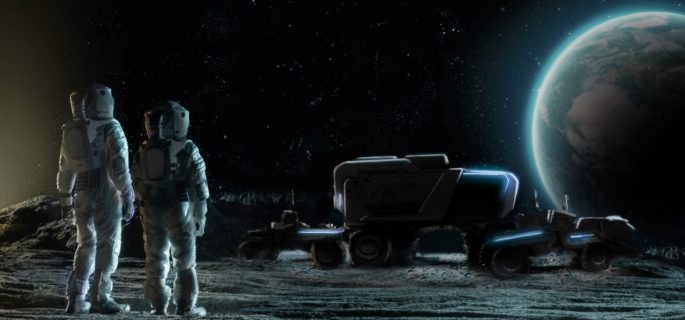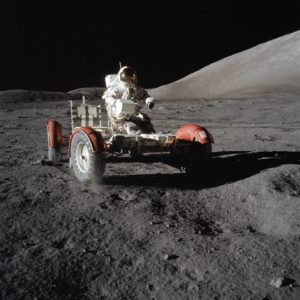Electric Cars on the Moon: GM and Lockheed Martin Partner to Design the Next Lunar Rover

A new generation of lunar rovers under development by Lockheed Martin and GM could be used by Artemis astronauts to extend and enhance the exploration of the surface of the moon.
When it comes time to send humans to the moon again in the future for new explorations, humankind will certainly not send the next astronauts there accompanied by an old-fashioned NASA lunar rover.
Of course not. Who wants them driving around in a lunar Model T from the 1970s in a time of Teslas and SUVs?
Instead, NASA has been seeking proposals from space engineering companies for new designs and ideas for what the next generation of lunar rovers – now called Lunar Terrain Vehicles (LTV) – will look like and how they will work on the future NASA Artemis moon missions.
With that in mind, General Motors and Lockheed Martin announced May 26 (Wednesday) a partnership to create their vision of the next LTV, which will be based on NASA’s future specifications and desires.
So far, the moon rover program is in its earliest stages, Kathryn Hambleton, a public affairs officer with the human exploration and operations mission directorate at NASA, told EnterpriseAI.
“NASA has not yet picked any companies to provide a Lunar Terrain Vehicle for use during Artemis missions on the surface of the Moon,” Hambleton wrote in an email reply to an inquiry. “NASA held an industry day in February 2020 and since that time has had discussions with many companies to inform our requirements. The agency is still defining its procurement strategy and has not yet issued a Request for Proposals.”
Though GM and Lockheed Martin have not yet begun their designs because NASA’s specifications and proposal requests are still being written, announcing the new partnership puts their flags into the ground and lays out their goals.
“To support NASA’s mission, the two industry leaders will develop a unique vehicle with innovative capabilities, drawing on their unparalleled engineering, performance, technology and reliability legacies,” the companies said in a press release. “The result may allow astronauts to explore the lunar surface in unprecedented fashion and support discovery in places where humans have never gone before.”
Spokespersons from GM and Lockheed Martin declined to comment further on their announcement when asked by EnterpriseAI.
Artemis: Back to the Moon
NASA’s Artemis missions call for a return to the moon by human astronauts by 2024, with a plan for sustained lunar explorations by humans by the mid- to late-2020s, according to NASA. The space agency is looking to include the most important technologies and features in the new rovers so that astronauts can have the tools they need to have successful missions.
These missions would be the first human explorations on the moon since 1972, when the crew of NASA’s Apollo 17 mission departed from the lunar surface. The last three Apollo missions, 15, 16 and 17, carried with them NASA’s first lunar rovers, which allowed the astronauts to cover more ground and explore more of the surface in their time outside their lunar landers. The earlier Apollo lunar rovers were powered by electricity, which is how the new rovers are expected to be powered as well.
NASA has asked today’s space vendors to build much more advanced LTVs which will allow astronauts to cover more distance and conduct a wider range of on-surface experimentation than the rovers on earlier Apollo missions. The next-generation LTVs are expected to be just the first of many types of surface mobility vehicles needed for NASA’s Artemis program, according to GM and Lockheed Martin.
Where AI Might Be Used in the Artemis Program
Several IT analysts told EnterpriseAI that they can see the use of AI being included in the upcoming lunar rovers and missions as they are proposed and developed.
“AI is becoming ubiquitous, especially in any self-controlled applications where latencies are unacceptable,” said Karl Freund, the founder and principal analyst for machine learning, HPC and AI with Cambrian AI Research. “After all, you don’t want to wait for hours to hear back from the earth, so self-control is essential, guided by AI analyses of on the ground or in the air with input sensors feeding AI accelerator chips.”
AI could be useful in both crewed and un-crewed space travels in the future, as well as in the design of spacecraft, mission operations, space communications, exploration of the cosmos and more, said Freund.
“AI will become the primary technology to program computers using unstructured data,” he said. “While it won’t replace SQL, C++ or even Fortran directly, AI will augment nearly all computation, from supercomputing to vision-guided vehicles to simple spreadsheets.”
Another analyst, Marc Staimer, president and chief data scientist with Dragon Slayer Consulting, agreed.
“NASA announced they are exploring the use of AI, specifically Spiky Neural Networks (SNN) in a variety of their projects,” said Staimer. “SNN requires much lower processing power and wattage and does not require transmission back to a core or cloud like convolutional neural networks.”
These technologies could be used in navigating and exploring the moon again using sensors, cameras for things like smell and feel, especially with robots, said Staimer.
“AI can be utilized with all sensors on the spacecraft – lidar, radar, life support (O2, CO2 sensors, temperature, etc.) alerting, adapting, etc.,” he said. “Because space is incredibly weight sensitive – the more weight that must escape Earth’s gravity, well, the more fuel is required which adds yet more weight and more fuel. SNN is where their AI research is going.”
AI Is Being Used Today on the Perseverance Mars Rover Mission
Since its landing on Mars on Feb. 18, NASA’s Perseverance Mars rover has been using a variety of AI technologies in its mission to explore the red planet.
To makes its two-year exploratory mission possible, Perseverance carries more AI capabilities and technologies than any Mars rover before it, including an AI-enabled Terrain Relative Navigation (TRN) system that aided the craft’s landing, and an Autonomous Exploration for Gathering Increased Science system (AEGIS), which consists of intelligent targeting software that allows mission engineers to remotely aim and control the rover’s SuperCam chemistry camera. The Mars rover also includes an improved autonomous navigation system that is fueled by AI.













